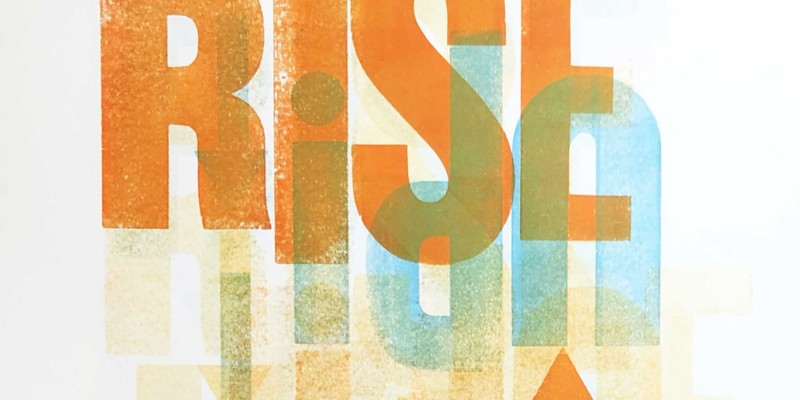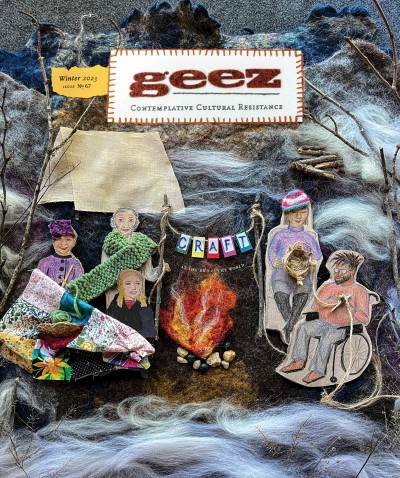Letterpress for What Ails You

Detail of “Rise Up,” Pete Railand, August 2021, Letterpress Relief Print, 51 x 76 cm (20 x 30 inches).
In today’s academic hellscape, you have a significantly better chance of surviving the Hunger Games than getting a tenure-track job.
From networking at expensive conferences, to integrating harsh feedback, to submitting endless drafts in the hopes of netting that precious peer-reviewed publication, the workload is overwhelming and all-encompassing. In that toxic atmosphere of “never good enough,” I often had trouble separating my personal and professional identities, convinced that being a subpar academic also meant I was a failure as a person.
While circling this drain, I was rescued by an unlikely practice: letterpress printing.
Letterpress is an outdated mode of relief printing that is now used by artisans who prefer the handcrafted to the machine-made. It involves assembling tiny pieces of movable type into a passage of text, placing this passage in an iron press, then using the press’s mechanics to apply ink, press paper against the type, and create a print. It’s not unlike an elaborate, customizable stamp.
I first encountered letterpress during my second year of a PhD program in English and Book History at the University of Toronto when I stumbled across the campus’s “Bibliography Room” – a little-known basement facility that housed six antique printing presses, countless cabinets of type, and a roster of volunteers. From that point, I visited the facility at least once a week over the next five years.
Letterpress offered a rebuttal to the exploitative world of the university. Where the academy required competition, the Bibliography Room provided community. I became friends with the other volunteers, collaborated on projects with my colleagues, and found an irreplaceable mentor in Nelson Adams, the facility’s manager and a beloved figure in the world of Canadian publishing.
In the Bib Room, I escaped the merciless grind of the corporate university and experienced the restorative powers of patience and intentionality. An impulsive person by nature, I learned to find pleasure in the slow pace of the printing process. The repetitive movements needed to set type and operate the press are the closest thing to meditation that I’ve ever experienced – a much needed reprieve for a lifelong overthinker.
Maybe most importantly, printing let me trade analysis and deconstruction for appreciation and creation. As a PhD student, I learned to read without pleasure. My task was to engage in literary criticism: breaking novels down to see how literary devices and tropes culminated in overarching themes. In the Bibliography Room, I did away with professional detachment and remembered why I wanted to study literature in the first place: because I loved it.
I found my way back to this simpler connection to literature by celebrating beloved novels and poems through letterpress art. I have fond memories of making a silly Valentine’s Day card inspired by Pride and Prejudice, printing poetry by El Jones and Sachiko Murakami, and devoting an entire piece to one line from Susan Sontag’s “Notes on Camp”: “Camp is a tender feeling.”
Creating the “Camp is a tender feeling” print was the pinnacle of my time in the Bibliography Room, where I learned to value the slow, soft, and gentle. Fittingly, Sontag’s essay is about choosing tenderness; she explains that the difference between bad art and adorably campy art is in the audience. If an enthusiastic, generous audience can look at an overwrought drama and find something to appreciate, they can transform a failure into a triumph. Deeming something to be camp means uniting in a collective “tender feeling.”
As I created this print – using an appropriately bubbly italic font and a palette of soft pink and purple inks – I extended its gentle message to myself. I gave myself permission to leave academia, tenderly transform my failure to acclimatize to an exploitative world as a triumph of self-respect, and move toward a softer way of living.
Veronica Litt is a hobbyist writer, podcaster, and letterpress printer who lives in Hamilton, Ontario. She holds a PhD in English and Book History from the University of Toronto. For her superpower craft, she’d choose weaving and sewing! She envisions the end of the world as having no power grid, so being able to make warm fleece jumpsuits would help us all get through the winter.



Start the Discussion